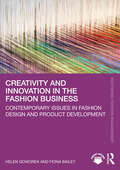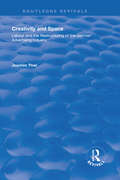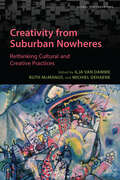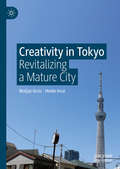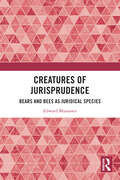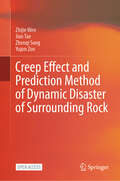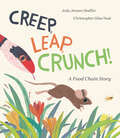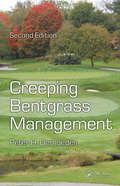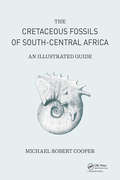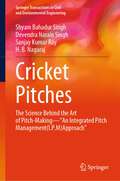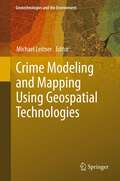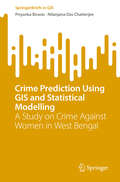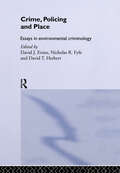- Table View
- List View
Creativity and Innovation in the Fashion Business: Contemporary Issues in Fashion Design and Product Development (Mastering Fashion Management)
by Helen Goworek Fiona BaileyCreativity and Innovation in the Fashion Business explores the ways in which creativity and innovation play a central role across the fashion industry, paying particular attention to design and technical perspectives. This topic is examined through careful theoretical analysis, incorporating the perspectives of multiple contributors who together possess a wealth of combined experience in creative and technical roles in the fashion business.Broad in scope, this textbook first provides a wide overview of creativity and innovative developments across the industry, before considering technical and digital innovation in production and product development, as well as trend forecasting. The final part of the book then consists of an exploration of sustainable innovation in design for fashion brands and retailers. Each chapter includes aims and summaries to structure learning and highlight key points, academic insights from thought leaders and interviews from industry and academia.A vital introductory textbook, Creativity and Innovation in the Fashion Industry is well-suited to undergraduate and postgraduate modules across subjects such as Fashion Business, Fashion Design and Manufacturing, Product Development, Innovation Management, and Buying and Merchandising. Online resources include PowerPoint slides and a test bank.
Creativity and Space: Labour and the Restructuring of the German Advertising Industry (Routledge Revivals)
by Joachim ThielOriginally published in 2005. By examining the changing patterns of the German advertising industry from a spatial-economic perspective, focusing on the rise of Hamburg as the country's new creative capital, this book discusses the shifting relations between economic organization, social relations and spatial structures in the post-industrial economy. It argues that it is the professional labour market which drives the organization and the spatial structure of knowledge-intensive activities. It does not, however, only imply the increasing importance of labour as a factor of production, but also suggests an increasing uncertainty linked to the nature of knowledge - labour. Illustrated by in-depth empirical material, the book brings together debates on reflexive modernization and individualization with those on embeddedness and on the role of business services in regional development. It concludes that it is the labour market of professionals which provides a regional and social anchoring of economic activities, while at the same time pointing out the increasing importance of metropolitan regions.
Creativity from Suburban Nowheres: Rethinking Cultural and Creative Practices (Global Suburbanisms)
by Ilja Van Damme Michiel Dehaene Ruth McManusLooking at suburbs as places of creativity gives rise to novel and thought-provoking narratives that typically run counter to the idea that suburbs are sites of "ordinary," "mundane," and "everyday" practices. Far from being geographies of "nowhere" – dull, materialistic, and monotone – suburbs are unpacked as being heterogeneous and historically layered places of living, work, and creation. Situating creativity in place and time, Creativity from Suburban Nowheres displaces mainstream understandings of creativity and widespread stereotypes commonly associated with the suburbs. Contributors explore the particular forms of creativity that suburbs elicit both in the process of their making, materialization, and community construction, and in the myriad ways in which suburbs are inhabited and experienced. They highlight accounts of suburbs as places that give people the space and latitude to shape individual and collective identities through creative practices at odds with mainstream culture, and often remote from the classic agglomeration "assets" associated with inner cities. Anchored in historical and geographical research, this volume highlights how and in what forms creativity should be understood in the suburbs, why and when creativity can be found, and how the notion of suburban creativity overthrows ingrained and dominant normative viewpoints. Rather than seeing creativity arise despite its suburban location, Creativity from Suburban Nowheres illuminates the emancipatory potential of suburbs for creativity.
Creativity in Tokyo: Revitalizing a Mature City
by Heide Imai Matjaz UrsicThis book focuses on overlooked contextual factors that constitute the urban creative climate or innovative urban milieu in contemporary cities. Filled with reflections based on interviews with a diverse range of creative actors in various local neighborhoods in Tokyo, it offers a rare glimpse into the complex set of elements that provide long-term, physical, and sociocultural support to urban creativity. Ursic and Imai highlight the interplay between physical and soft (social) factors in the process of place-making and explore how a city’s creativity is influenced by financial support and accessible infrastructure, as well as the sets of informal networks, services, and tacit, locally embedded knowledge that provide the basic layers of stimuli needed for creativity to fully develop. The authors show how the future development of creativity and the overall development of a city depend not only on the (top-down) planning strategies of formal authorities, but also on the appropriate (bottom-up) inclusion of heterogeneous elements that are provided and embedded within the small, hidden context of city spaces.
Creatures of Jurisprudence: Bears and Bees as Juridical Species
by Edward MussawirTo what extent can an animal constitute a ‘juridical species’? This highly original book considers how animals have been integral to law and to legal thinking.Going beyond the traditional approaches to animal rights and the question of whether non-human animals may be considered legal ‘subjects,’ this book follows two types of animal – bears and bees – and asks what existence these species have maintained in juridical thought. Uncovering surprising roles that the animals play in the imagination of and solution to jurisprudential problems, the book offers a counter-argument to the view that juridical thought reduces one’s appreciation for the singularity and independence of their lives. It shows, rather, that the animals exert a remarkable influence on the creative dimensions of law, offering a liveliness to it that is worthy of close attention.Contributing to new directions at the intersection of jurisprudence and human–animal studies, this book will appeal to those with interests in either of these areas.
Creep Effect and Prediction Method of Dynamic Disaster of Surrounding Rock
by Jian Tao Zhijie Wen Zhenqi Song Yujun ZuoThis open access book provides a comprehensive overview of the author&’s in-depth insights into the theory, prediction methods, and developmental trends of creep instability and failure in coal-rock masses within mining stopes. The content primarily covers topics such as creep instability of coal-rock masses in stopes, creep instability of surrounding rock in roadways, large-scale roof creep instability, creep instability of overlying strata in goaf, rockburst, gas outburst, and principles and prediction of roof creep instability in fully mechanized mining faces. Additionally, it explores theoretical advancements in analyzing the energy principles of coal-rock masses and acoustic wave monitoring of coal-rock systems. This book serves as a valuable reference for professionals and researchers in mining engineering, mine construction, underground space engineering, and geotechnical engineering, as well as for faculty and students in related fields.
Creep, Leap, Crunch! A Food Chain Story
by Jody Jensen ShafferIn this nonfiction picture book, discover how the animal kindgdom's food chain takes shape, from the lowly worm to the mighty king of the jungle.There was a blue sky with a bright shining sun,A dazzling, life-giving, fiery sun.The day had begun. Follow along as a day in the life of the food chain begins. From the sun that shines upon the grass and trees to the animals that feed each other, each element in nature has its place. But what happens when the food escapes? This cumulative story will delight, with a surprise ending that all science lovers will enjoy.
Creeping Bentgrass Management
by Peter H. DernoedenCreeping bentgrass is considered the premier turfgrass species grown on golf courses, and there is a growing demand for an understanding of its maintenance and management practices. Still the only comprehensive reference on the subject, Creeping Bentgrass Management, Second Edition helps you identify the factors that contribute to summer bentgrass
Cretaceous Fossils of South-Central Africa: An Illustrated Guide
by Michael Robert CooperThis book serves as an introduction to the Cretaceous geology and palaeontology of south-central Africa, covering the whole of Southern and Eastern Africa and Angola. Fifty two plates illustrate almost 1000 species and provide a field guide to the macrofossils of the subcontinent. The book will be of value to field geologists, students and non-specialists with an interest in the natural world. A bibliography of the Cretaceous palaeontology and stratigraphy of the subcontinent is provided. Features: Provides a concise account of the Cretaceous geology for 13 African regions Includes beautiful illustrations and a comprehensive bibliography Fossils are presented in stratigraphical order, allowing easy determination of the age deposits.
Cricket Pitches: The Science Behind the Art of Pitch-Making—“An Integrated Pitch Management (I.P.M) Approach” (Springer Transactions in Civil and Environmental Engineering)
by Devendra Narain Singh Shyam Bahadur Singh Sanjay Kumar Ray H. B. NagarajThe book develops a practical understanding of the fundamental scientific principles and logic underlying the art of turf pitch preparation, measuring, analysing, and interpreting pitch surface behaviour. It’s an attempt to understand how the captains, players, coaches, curators, and groundsmen comprehend and analyse the cricket pitch behaviour (days before and during the matches) and whether the pitch behaviour can be standardised and quantified (through bench marking or forming a data-based management system (DBMS) of a pitch profile, pitch quality standards, a pitch behaviour analysis index (PBAI), or pitch behaviour forecasting (PBF) by examining or analysing its mineralogical, chemical, physical, or morphological compositions, weather variables, and different pitch preparation methods and techniques. Individual chapters in this book deal with clay mineralogy, the bench-marking of cricket pitch soils, pitch soil chemical properties, pitch soil water, pitch turf grass, pitch soil organic matter, integrated rolling management, soil structure, and compressibility. This is an effort to decipher the impact of each and every major and minor component of pitch soil, which controls the pitch behaviour either in large or small magnitudes but acts as a critical factor in defining and shaping the pitch behaviour as a whole. Several real-life examples, pitch interviews, scenarios, and case studies as felt and observed by the curator( first author) during the preparation of various international, national, and board matches or during the construction and renovation of new wickets have been included in each and every relevant chapter so as to analyse, interpret, comprehend, and justify the theoretical science with the existing practises involved in pitch construction, preparation, or judging the complex nature of pitch behaviour. Based on findings through the DBMS, PBAI, and PQS of cricket pitch profiles, various innovative and simple methods of analysing, comprehending, and forecasting pitch behaviour have been devised that will enable one to judge and comprehend the complex pitch behaviour in simple ways.
Crime Modeling and Mapping Using Geospatial Technologies (Geotechnologies and the Environment #8)
by Michael LeitnerRecent years in North America have seen a rapid development in the area of crime analysis and mapping using Geographic Information Systems (GIS) technology. In 1996, the US National Institute of Justice (NIJ) established the crime mapping research center (CMRC), to promote research, evaluation, development, and dissemination of GIS technology. The long-term goal is to develop a fully functional Crime Analysis System (CAS) with standardized data collection and reporting mechanisms, tools for spatial and temporal analysis, visualization of data and much more. Among the drawbacks of current crime analysis systems is their lack of tools for spatial analysis. For this reason, spatial analysts should research which current analysis techniques (or variations of such techniques) that have been already successfully applied to other areas (e.g., epidemiology, location-allocation analysis, etc.) can also be employed to the spatial analysis of crime data. This book presents a few of those cases.
Crime Prediction Using GIS and Statistical Modelling: A Study on Crime Against Women in West Bengal (SpringerBriefs in GIS)
by Nilanjana Das Chatterjee Priyanka BiswasThe study presented in this SpringerBrief uses GIS tools to analyze incidents of violence against women in West Bengal India, identifying “hotspots” and offering tools and strategies to predict and prevent future violence. The aim of this study is to understand the existing scenarios and the complex crime patterns committed against women in West Bengal, using advanced GIS tools to map and understand the underlying socio-economic and physical environmental contexts of specific crime events, and critically discussed emerging criminogenic issues on the basis of theoretical understanding and immediate situations. This study evaluates the effectiveness of existing legislative measures to extract the gaps that exist between policy formulation and execution and effectively applied statistical methods and GIS technologies to visualize the future potential crime areas so that possible measures might be taken. The study considers four categories of violence perpetrated on women: human trafficking, acid attacks, rape and sexual harassment. Each chapter follows a self-contained design to address the study objectives as each crime follows distinct crime pattern, differentially affects the targets and increase risk of victimization and differential key factors are responsible for specific crime occurrences.
Crime, Policing and Place: Essays in Environmental Criminology
by David T. Herbert Nicholas R. Fyfe David J. EvansFirst published in 2002. Routledge is an imprint of Taylor & Francis, an informa company.
Crimen climático: Cómo el calentamiento global está provocando un genocidio
by David LizoainEl título de este libro no debería sorprendernos. Hoy toda política es política climática, y está en juego quién vive y quién muere. Estamos viviendo un momento decisivo para el planeta, que se encuentra al borde del colapso por culpa de las acciones humanas. En este fascinante ensayo de naturaleza optimista, aunque en ocasiones pueda parecer lo contrario, David Lizoain señala a los principales responsables de la actual emergencia climática y expone los puntos clave para un Green New Deal, ese indispensable proyecto de reestructuración económica masiva con el que lograríamos evitar el colapso y que culminaría en un nuevo régimen social y energético: el socialismo solar. Se espera que a lo largo de esta década vayan sucediéndose incontables desastres (pandemias, olas de calor, la pérdida de hábitats hasta ahora intactos, un descenso significativo de la biodiversidad...), algunos de los cuales ya han comenzado a desplegar sus terribles efectos. Estos no hacen sino confirmar la más que urgente necesidad de una transformación sin precedentes. ¿Podemos afirmar que lo que está ocurriendo es un genocidio climático? Es la pregunta que plantea Lizoain al inicio del libro. Su respuesta, clara y contundente, es que nadie más que el hombre, con su obsesión por el crecimiento perpetuo, ha abonado el terreno para la catástrofe. El nuestro es ya un mundo de eco-apartheid, y el genocidio climático tiene lugar gracias a la complicidad generalizada de los poderosos. Es hora de terminar con la impunidad, movilizarse y lograr una ruptura radical (y sostenible) con el statu quo.
Crimes Against Nature: How George W. Bush and His Corporate Pals Are Plundering the Country and Hijacking Our Democracy
by Robert F. KennedyIn this powerful and far-reaching indictment of George W. Bush's White House, Robert F. Kennedy, Jr., the country's most prominent environmental attorney, charges that this administration has taken corporate cronyism to such unprecedented heights that it now threatens our health, our national security, and democracy as we know it.
Criminal Anthroposcenes: Media and Crime in the Vanishing Arctic (Palgrave Studies in Crime, Media and Culture)
by Matthew Tegelberg Anita LamThis book compares and contrasts traditional crime scenes with scenes of climate crisis to offer a more expansive definition of crime which includes environmental harm. The authors reconsider what crime scenes have always included and might come to include in the age of the Anthropocene – a new geological era where humans have made enough significant alterations to the global environment to warrant a fundamental rethinking of human-nonhuman relations. In each of the chapters, the authors reframe enduringly popular Arctic scenes, such as iceberg hunting, cruising and polar bear watching, as specific criminal anthroposcenes. By reading climate scenes in this way, the authors aim to productively deploy the representation of crime to make these scenes more engaging to policymakers and ordinary viewers. Criminal Anthroposcenes brings together insights from criminology, climate change communication, and tourism studies in order to study the production and consumption of media representations of Arctic climate change in the hope of to mobilizing more urgent public and policy responses to climate change.
Crisis Gardening: A Global Perspective (Advances in Agroecology)
by Monika EgererGardening during times of crisis can have significant benefits to individuals and populations interms of health, well-being, social and economic outcomes. So-called ‘crisis gardening’ can even belinked to transformative change in food systems through socio-ecological aspects of agroecology.In this book, crisis gardening is explored to better define, describe and provide recommendationsabout this activity globally. Diverse perspectives are offered from scholars around the world, providingan overview of gardening during crises with ties to agroecology. Such a perspective is criticalas we grapple with food system crises, pandemics, climate change, biodiversity loss, mental healthissues and political conflict globally.• The first section defines and explains crisis gardening in relation to agroecology, transformative change in food systems and public health.• The second section describes case studies from around the world of crisis gardening from various social-ecological perspectives.• The third section provides policy and practice recommendations and how to scale up the lessons from crisis gardening to transform food systems, public health systems, and policy and landscape planning processes.Bringing together leaders and experts (academics, policy makers and practitioners) from around theworld, the book provides case studies of crisis gardening and develops recommendations to harnessthe lessons from this practice.
Crisis Management in the Tourism Industry: Beating the Odds? (New Directions in Tourism Analysis)
by Christof PforrAn important challenge facing tourism is the anticipation of the threat of crises precipitated by natural and people-made catastrophes, and being adequately prepared for them. Despite an increase in research on this issue there is still a considerable lack of clarity on the impacts of crises on the tourism industry. Illustrated by a range of international case studies, this book provides a systematic and conceptual approach to questions such as how tourism businesses prepare for and react to crisis, which measures are taken and what impact they have, and which strategies can be employed to overcome them. By discussing, analyzing and synthesizing the literature on crisis management, the authors question how business can become more proactive in preparing and dealing with crises in the tourism industry.
Crisis Management, Destination Recovery and Sustainability: Tourism at a Crossroads
by James Kennell Azizul Hassan Anukrati Sharma Priyakrushna MohantyThe COVID-19 pandemic brought travel to a halt and the global tourism industry has been one of the sectors hit hardest during the pandemic. This book looks at how the tourism industry can enhance its resilience and prepare for future crises more effectively. The book provides insights into the economic, social, geopolitical and environmental implications of the COVID-19 pandemic on the tourism and hospitality industries and the responses in diverse international contexts. It highlights key concepts and includes cases with real-life applications. The book also discusses future research directions in a post-pandemic scenario. This book will be an invaluable resource for practitioners in the areas of tourism and crisis management and for readers to compare and contrast tourism destination recovery and crisis management practices through different research methodologies and settings.
Crisis Spaces: Structures, Struggles and Solidarity in Southern Europe (Routledge Studies in Human Geography)
by Costis HadjimichalisThe financial malaise that has affected the Eurozone countries of southern Europe – Spain, Portugal, Italy and, in its most extreme case, Greece – has been analysed using mainly macroeconomic and financial explanations. This book shifts the emphasis from macroeconomics to the relationship between uneven geographical development, financialization and politics. It deconstructs the myth that debt, both public and private, in Southern Europe is the sole outcome of the spendthrift ways of Greece, Spain, Italy and Portugal, offering a fresh perspective on the material, social and ideological parameters of the economic crisis and the spaces where it unfolded. Featuring a range of case examples that complement and expand the main discussion, Crisis Spaces will appeal to students and scholars of human geography, economics, regional development, political science, cultural studies and social movements studies.
Crisis Urbanism and Postcolonial African Cities in Postmillennial Cinema (Routledge Research on Decoloniality and New Postcolonialisms)
by Addamms MututaThis book provides a framework to rethink postcoloniality and urbanism from African perspectives. Bringing together multidisciplinary perspectives on African crises through postmillennial films, the book addresses the need to situate global south cultural studies within the region. The book employs film criticism and semiotics as devices to decode contemporary cultures of African cities, with a specific focus on crisis. Drawing on a variety of contemporary theories on cities of the global south, especially Africa, the book sifts through nuances of crisis urbanism within postmillennial African films. In doing so the book offers unique perspectives that move beyond the confines of sociological or anthropological studies of cities. It argues that crisis has become a mainstay reality of African cities and thus occupies a central place in the way these cities may be theorized or imagined. The book considers crises of six African cities: nonentity in post-apartheid Johannesburg, laissez faire economies of Kinshasa, urban commons in Nairobi, hustlers in postwar Monrovia, latent revolt in Cairo, and cantonments in postwar Luanda, which offer useful insights on African cities today. The book will be of interest to students and scholars of urban studies, urban geography, urban sociology, cultural studies, and media studies.
Crisis Without End: The Medical and Ecological Consequences of the Fukushima Nuclear Catastrophe
by Helen CaldicottExpert essays provide the first comprehensive analysis of the long-term health and environmental consequences of the Fukushima nuclear accident. On the second anniversary of the Fukushima disaster, an international panel of leading medical and biological scientists, nuclear engineers, and policy experts were brought together at the prestigious New York Academy of Medicine by Helen Caldicott, the world&’s leading spokesperson for the antinuclear movement. This was the first comprehensive attempt to address the health and environmental damage done by one of the worst nuclear accidents of our times. A compilation of these important presentations, Crisis Without End represents an unprecedented look into the profound aftereffects of Fukushima. In accessible terms, leading experts from Japan, the United States, Russia, and other nations weigh in on the current state of knowledge of radiation-related health risks in Japan, impacts on the world&’s oceans, the question of low-dosage radiation risks, crucial comparisons with Chernobyl, health and environmental impacts on the United States (including on food and newborns), and the unavoidable implications for the US nuclear energy industry. Crisis Without End is both essential reading and a major corrective to the public record on Fukushima.
Crisis and Emergency Management in the Arctic: Navigating Complex Environments (Routledge Studies in Hazards, Disaster Risk and Climate Change)
by Natalia Andreassen and Odd Jarl BorchThis book sheds light on the management challenges of crisis and emergency response in an arctic environment. It explores how the complexity of the operational environment impacts on the risk of operations and addresses a need for tailor-made emergency response mechanisms. Through case studies of the arctic environment, the book illustrates how factors such as nature, geography, demographics and infrastructure increase the complexity of crises in the Arctic and present a significant danger to life and health, the environment and values in challenging Arctic waters. The case studies lay a special focus on contextual factors including conflicting interests and different stakeholder groups, as well as the institutional platforms influencing crisis response and emergency management. They also explore the implications for the managerial roles, the mode of operations, and the structuring of the organizations responsible for the emergency response. The necessity to facilitate cooperation across organizations and borders and a need for organizational flexibility in large scale operations are also emphasized. Written in an accessible style, this book will make for a useful resource for undergraduate and postgraduate students of disaster and emergency management, as well as for professionals involved in emergency services.
Crisis and Migration: Critical Perspectives (Routledge Studies in Development, Mobilities and Migration)
by Anna LindleyCrisis and migration have a long association, in popular and policy discourse as well as in social scientific analysis. Despite the emergence of more nuanced and even celebratory accounts of mobility in recent years, there remains a persistent emphasis on migration being either a symptom or a cause of crisis. Moreover, in the context of a recent series of headline-hitting and politically controversial situations, terms like ‘migration crisis’ and ‘crisis migration’ are acquiring increasing currency among policy-makers and academics. Crisis and Migration provides fresh perspectives on this routine association, critically examining a series of politically controversial situations around the world. Drawing on first-hand research into the Arab uprisings, conflict and famine in the Horn of Africa, cartel violence in Latin America, the global economic crisis, and immigration ‘crises’ from East Asia to Southern Africa to Europe, the book’s contributors situate a set of contemporary crises within longer histories of social change and human mobility, showing the importance of treating crisis and migration as contextualised processes, rather than isolated events. By exploring how migration and crisis articulate as lived experiences and political constructs, the book brings migration from the margins to the centre of discussions of social transformation and crisis; illuminates the acute politicisation and diverse spatialisations of crisis–migration relationships; and urges a nuanced, cautious and critical approach to associations of crisis and migration.
Crisis and Order in English Towns 1500-1700: Essays In Urban History
by Peter Clark Paul SlackThis collection of essays in English urban history covers a period which has been called 'the Dark Ages in English Economic History', on which it directs a revealing light. The essays range from a discussion of the role of ceremony in the civic life of Coventry at teh end of the Middle Ages to the influence of war on London Merchant class at the end of the seventeenth century. This book was first published in 1972.
